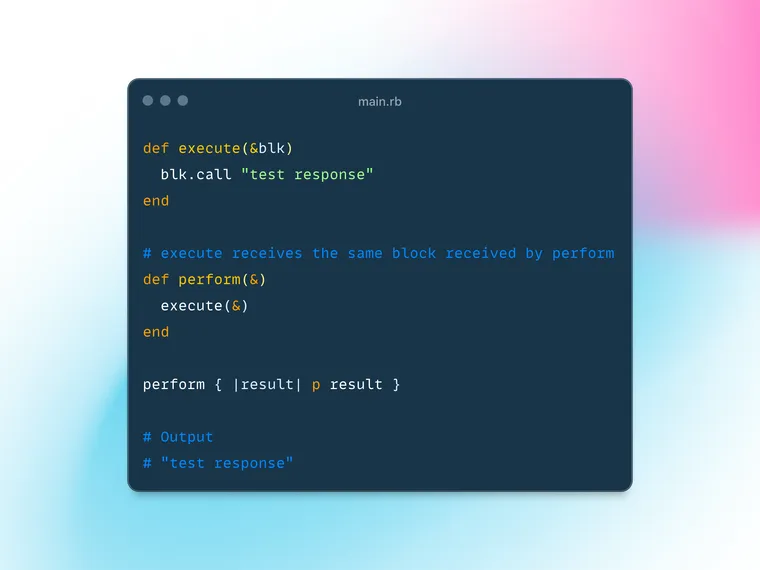You probably have used (or at least heard about) the argument forwarding feature in Ruby, which was added in Ruby 2.7, that lets you forward all the arguments passed to a method, as they are, to another method, using the three dots ... syntax.
This includes all positional, named, and even block arguments.
def execute(action="", **options)
p action # get
p options # {:url=>"/test", :values=>[201, 202]}
yield "fake response"
end
def perform(...)
# execute receives all the arguments
# received by the perform function
execute(...)
end
perform action="get", url: "/test", values: [201, 202] do |result|
p result # "fake response"
endDid you know that there's a similar shorthand to forward a block anonymously? I learned this very recently (yesterday!), and I love it.
Notice the perform method in the following example:
def execute(&blk)
yield "response 1"
blk.call "response 2"
end
def perform(&)
# execute receives the same block
# received by the perform function
execute(&)
end
perform do |result|
p result
end
# Output:
# "response 1"
# "response 2"Earlier, you'd have done something like:
def perform(&blk)
execute(&blk)
endBut starting in Ruby 3.1, you can do this:
def perform(&)
execute(&)
endPretty cool, right? Also looks pretty nice, in my opinion. What do you think?
If you like this syntax, and would like to enforce it via Rubocop (Rails 8 ships with a default Rubocop linter out of box), you can use the following Rule:
Naming/BlockForwarding:
EnforcedStyle: anonymousOn the other hand, if you prefer the older explicit version, enforce it with this rule:
Naming/BlockForwarding:
EnforcedStyle: explicitP.S. For an in-depth explanation, I suggest reading this post from zverok. It goes into much more depth.
That's a wrap. I hope you found this article helpful and you learned something new.
As always, if you have any questions or feedback, didn't understand something, or found a mistake, please leave a comment below or send me an email. I reply to all emails I get from developers, and I look forward to hearing from you.
If you'd like to receive future articles directly in your email, please subscribe to my blog. If you're already a subscriber, thank you.

